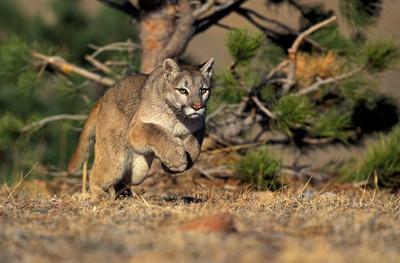Most urban sightings cause no conflict
WHITE SALMON — Most cougars who wander into urban areas simply leave, quietly, without making trouble for the human residents. Adult males may even protect you from encounters with other cougars, by defending territories from inexperienced wandering juveniles. An injured cougar who stayed in White Salmon two months ago was the exception, Wildlife Conflict Specialist Todd Jacobsen said. Because it could no longer walk well, it could not wander.
Jacobsen, who works for Washington Department of Fish and Wildlife (WDFW), retrieved the 24-month-old male cougar’s body after law enforcement euthanized it, due to its injuries, on Dec. 7.
The call came to White Salmon-Bingen Police at about 10:30 p.m. that day: An injured cougar was walking through someone’s property in town. Officer Chuck Parsons responded to near the 200 block of SE Oak Street.
The injured young male had been in the area for a while, Jacobsen said in an email. Eyewitnesses and trail cameras “indicated a cougar had been dragging one or both of its back legs and was unable to walk well,” he said. These were reported to WDFW, and local law enforcement, before Dec. 7.
“This particular incident may stand out because the cougar was injured or lingered longer than usual, but it’s not unusual for cougars to travel through populated areas in the Columbia River Gorge,” Jacobsen said. What’s rare is that anyone notices, let alone conflicts with, the cats.
Injuries are not uncommon, especially for juvenile cats dispersing in search of their own territory. Risks include territorial conflict (i.e. fights) with other cougars, struggles with prey, and vehicle collisions. Cougars are highly territorial, and these uneducated youngsters may also wander into urban areas.
“The cougar was ultimately located and humanely dispatched ... due to the extent of its injuries,” noted the police report.
After Parsons arrived, he got a phone call from Sergeant Adam Dyment, a county deputy. Dyment offered to call out a tracking hound, pending approval from Sheriff Bob Songer.
Michael Essex and his hound, Scrapper, were sent. After the pair had been searching for 15 or 20 minutes, dispatch advised the cougar was in a yard on the 400 block of the same street. The animal had gotten about 200 feet.
Scrapper, the hound, broke away from Essex and chased the cougar south toward Dock Grade, over an embankment, and eventually into a tree.
Young, dispersing males like this leave their mother’s territory at about two years old, and may walk more than 150 miles — while avoiding contact with older, territorial males — before claiming their own land, Jacobsen wrote. They often follow lines of forest or waterways through urban areas, following deer or other edible things.
Thus, a large male cougar may limit the number of youngsters within his territory by chasing them away — actually reducing interactions with humans and livestock. This adult male cougar may effectively protect the humans and livestock within its territory from encounters with other big cats.
However, less capable at hunting than their elders, and forced to skirt already claimed territories, young cougars sometimes discover that urban places can hold easier prey like “deer, turkeys, raccoons or domestic animals,” and may linger in populated areas.
Normally, these exploring cougars are secretive and cautious of humans, and leave urban areas without causing trouble. WDFW staff monitor sightings in populated areas, and Jacobsen said most of them simply move on, before causing concern. In the rare cases where they remain, staff work with communities to address concerns before conflict occurs.
To this end, Jacobsen advised residents can remove things cougars like from their property: Keep pet food indoors, use bear-proof garbage cans, avoid feeding wildlife or feral cats. Avoid planting vegetation that attracts deer, prune shrubs and trees where children play; if you have domestic animals, keeping them in secure pens away from the forest is “key,” he said. “These are proactive steps people can take even if there hasn’t been a recent cougar sighting.”
This reduces a healthy cougar’s chance of getting accustomed (or “habituated”) to domestic food. If the cougar does get too accustomed to people and is deemed dangerous, or eats domestic animals, law enforcement may still be tasked with killing the animal.
But this wasn’t a normal cougar. “As this cougar was injured and unable to hunt prey normally, it may have tried to find easier prey within city limits,” Jacobsen said. The animal did not harm any people during its foray into White Salmon.
The deputy and officers drove to Dock Grade and located the cat in its tree. Parsons shot the cougar three times in the neck and head, while it was still in the tree. On the third shot, the cat fell.
Then Parsons shot the cougar three more times in the head and neck with a rifle; then shot it with a handgun, killing it.
Essex dragged the body out of public view, and Jacobsen retrieved it the next day. The whole incident took about three hours.
“When a cougar is killed, whether by legal harvest, poaching, roadkill, or to protect public safety, WDFW inspects the carcass and collects samples,” Jacobsen wrote. WDFW staff figure out the cat’s sex, extract a tooth for lab analysis to confirm its age, and check for injuries or abnormalities. DNA samples are taken, to study its genetics.
This cat was “severely emaciated, had multiple compound fractures, a severe infection, and additional minor injuries due to its inability to walk.”























Commented
Sorry, there are no recent results for popular commented articles.